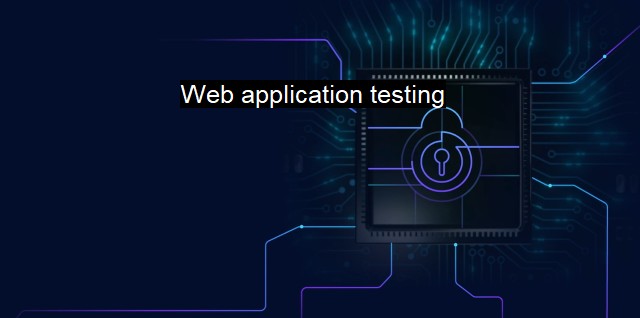What is Web application testing?
Ensuring Web Application Security through Rigorous Testing: Exploring the Importance of Web Application Testing and its Types
Web application testing, with is a crucial component in the creation, maintenance, and protection of web resources. It refers to series of processes and practices whereby different types of software tests are implemented on web-based applications to ensure that they meet the required security standards to avoid exploitation and attacks.Cybersecurity and antiviruses utilize robust testing mechanisms thoroughly examining web applications for potential loopholes. Web application testing entails the employment of specific software testing methods such as functionality testing, usability testing, performance testing, compatibility testing, and most importantly, security testing.
Security testing, in particular, falls directly into the cybersecurity domain and is arguably the most critical aspect of web application testing in terms of averting security threats. This protocol identifies potential weaknesses and vulnerabilities in the system that could enable cyber-attacks or cyber threats compromising data integrity and privacy. From SQL injections, Cross-Site Scripting (XSS), to Distributed Denial of Service (DDoS) attacks, these malicious actions aim to exploit weak spots in the application.
The importance of web application security testing in cybersecurity is pivotal in that it detects vulnerable points within an application which, if unaddressed, can be exposed by hackers. Therefore, this level of security testing bolsters the defenses against such threats, safeguarding the application and data housed.
Within antivirus context, web application testing is valuable since it helps in verifying that the antivirus software is functioning correctly to secure web applications. Antivirus software, functioning as the gatekeepers, must detect, deter, and eliminate any potential malware designed to take advantage of vulnerabilities within the application.
Web application testing also encompasses penetration testing or ethical hacking whereby authorized simulated attacks on systems are carried out to identify vulnerabilities. With penetration testing, analysts expose apparent and obscure weaknesses within a web application's code. Locating a vulnerability and applying the relevant patch before malicious hackers identify the opportunity considerably elevates an online platform's resilience.
More so, in the evolving digital world, with increasingly sophisticated cyber threats, the necessity for web application testing is on a trajectory upwards. The testing emphasizes the use of automated tools and software for efficiency and effectiveness, which can identify and leverage vulnerabilities, defective functions, or outdated software patches.
Web applications often interact with various databases, systems, and software to function fully. Web application testing assures these interactions or integrations are secure, enhancing confidence in the application with protection throughout every facet. This function is vital when considering the serious challenges posed by malicious elements hoping to exploit perceived lapses in security exceptionally resolution around shared systems.
This testing practice helps protect against potential consequences tied to data breaches which could be devastating to both claim and reputation, whether to individuals or commercial entities. In addition to loss of sensitive data, entities often grapple with financial losses, diminished brand reputation or client trust, regulatory penalties, and even possible legal ramifications.
Last but not least, education plays a crucial component in fortifying systems against threats, and web application testing is a part of that insight improvement. By thoroughly testing web applications, teams can grow their understanding of potential vulnerabilities, capitalize on security enhancements, and essentially learn what not to do in the future, generated from real instances of trial and error.
Web application testing in the context of cybersecurity and antivirus is a fundamental practice for all web applications. This assurance by testing allows for these applications to serve their purpose without fear of security breaches or malware attacks. It is a procedure necessitated before deployment or release and one applied frequently to ensure security patches remain updated. Cybersecurity professionals instrumentalize application testing as an additional layer of defense, ensuring that malicious hackers are always left without an element of surprise. Thus, proactive security measures in testing safeguard against malicious threats, foster trust with customers, and ascertain the longevity of web applications.

Web application testing FAQs
What is web application testing?
Web application testing is the process of evaluating a web-based software application for potential security vulnerabilities, system crashes, and poor user experiences. Testing helps ensure the application is secure, reliable, and performs as intended.Why is web application testing important in cybersecurity?
Web application testing is critical in cybersecurity because web-based applications are often the target of cyberattacks. Testing helps identify potential weaknesses that hackers could exploit to gain unauthorized access, steal sensitive data, or cause system disruptions.What are the different types of web application testing?
There are various types of web application testing, including functional testing, security testing, load testing, and compatibility testing. Functional testing evaluates if the application meets its functional requirements, while security testing assesses the application's security posture. Load testing evaluates the application's performance under heavy traffic, and compatibility testing checks if the application works correctly across different devices and browsers.What is antivirus web application testing?
Antivirus web application testing is a type of security testing that evaluates how a web application interacts with antivirus software. This testing ensures that the application does not conflict with antivirus software and is not blocked by the software's protections. It also checks for potential vulnerabilities that antivirus software may not detect.| | A | | | B | | | C | | | D | | | E | | | F | | | G | | | H | | | I | | | J | | | K | | | L | | | M | |
| | N | | | O | | | P | | | Q | | | R | | | S | | | T | | | U | | | V | | | W | | | X | | | Y | | | Z | |
| | 1 | | | 2 | | | 3 | | | 4 | | | 7 | | | 8 | | |||||||